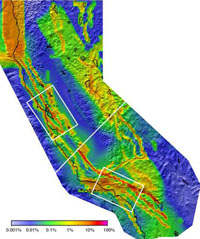From the Associated Press, via the New York Times:
LOS ANGELES (AP) — California faces an almost certain risk of being rocked by a strong earthquake by 2037, scientists said in the first statewide temblor forecast.
New calculations reveal there is a 99.7 percent chance a magnitude 6.7 quake or larger will strike in the next 30 years. The odds of such an event are higher in Southern California than Northern California, 97 percent versus 93 percent.

I read this report with a certain sense of wonder. What impressed me was not the prediction itself; it’s not the first time I’ve heard that the Big One is coming. What took me by surprise was the level of mathematical sophistication that we can now take for granted in readers of the morning newspaper. No more do we have to worry that people will add up 97 percent and 93 percent to get 190 percent. Evidently, we’ve reached a state of universal numeracy, where everyone knows how to combine probabilities, and there’s no need to explain the calculation. We don’t even need to remind anyone that when we compute 1 – (1 – p)(1 – q), or p + q – pq, we are assuming that p and q represent probabilities of statistically independent events; everybody knows that. And everybody understands that in this context “a chance of a quake” really means “a chance of at least one quake.”
I guess the only place where we might still stumble is in actually doing the arithmetic. My calculator tells me the number is 99.8 percent, not 99.7.
A further note: The original report on which the news item is based leaves me even more perplexed. The probability model adopted in the forecast is explained as follows:
The simplest assumption is that earthquakes occur randomly in time at a constant rate; i.e., they obey Poisson statistics. This model, which is used in constructing the national seismic hazard maps, is “time independent” in the sense that the probability of each earthquake rupture is completely independent of the timing of all others. Here we depart from the… conventions by considering “time-dependent” earthquake rupture forecasts that condition the event probabilities… on the date of the last major rupture. Such models… are motivated by the elastic rebound theory of the earthquake cycle…; they are based on stress-renewal models, in which probabilities drop immediately after a large earthquake releases tectonic stress on a fault and rise as the stress re-accumulates due to constant tectonic loading of the fault.
In other words, it doesn’t sound as though the assumption of independence is even approximately satisfied. I must be missing something. The 99.7 percent combined probability is mentioned in the executive summary of the report, but I found no explanation of how that number was calculated.
Perhaps I shouldn’t worry so much. I live thousands of kilometers away in a zone of seismic serenity.
Update, several hours later: After reading a little more carefully, I think the report does assume that all possible earthquake sites are independent. At each site the probability of an event is a function of time, but it is independent of probabilities at other sites. Thus calculating a joint probability for the northern and southern parts of the state does seem to be a valid operation. And the distinction between “exactly one” and “at least one” doesn’t really enter into the matter either. That’s because the model is only valid until the next major earthquake occurs; after that, all bets are off, since the time-dependent probabilities have to be recalculated.
If this interpretation of the model is correct, I think the way the result is expressed is somewhat misleading. To say there’s a 97 percent chance in Socal and a 93-percent chance in Nocal implies there’s a high probability (90.2 percent) of seeing both events in the course of the 30-year period. But the model is no longer valid after the first quake.
I wonder if there isn’t a better way to express the concept at the heart of this story. Qualitatively, it’s easy enough to grasp: In the next 30 years there will almost certainly be a major earthquake somewhere in California, and the event is more likely to happen in the southern part of the state than in the northern part. Putting this into numbers is somewhat tricky—or at least I’ve had a lot of trouble with it. Having finally surrendered to the computer and performed a Monte Carlo simulation, I come up with this statement: There’s a 99.8 percent chance that the next major California earthquake will happen by 2037. If indeed such a quake occurs, the odds are about 57 to 43 it will hit in Southern California.